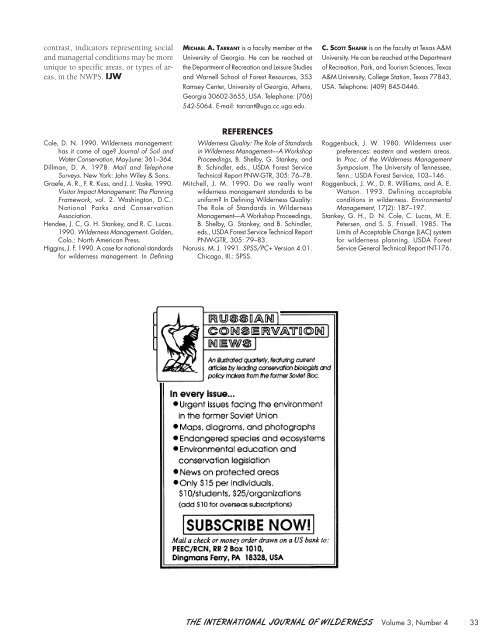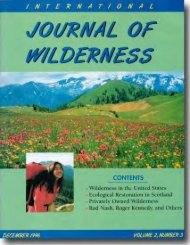Download full PDF - International Journal of Wilderness
Download full PDF - International Journal of Wilderness
Download full PDF - International Journal of Wilderness
Create successful ePaper yourself
Turn your PDF publications into a flip-book with our unique Google optimized e-Paper software.
contrast, indicators representing social<br />
and managerial conditions may be more<br />
unique to specific areas, or types <strong>of</strong> areas,<br />
in the NWPS. IJW<br />
Cole, D. N. 1990. <strong>Wilderness</strong> management:<br />
has it come <strong>of</strong> age? <strong>Journal</strong> <strong>of</strong> Soil and<br />
Water Conservation, May-June: 361–364.<br />
Dillman, D. A. 1978. Mail and Telephone<br />
Surveys. New York: John Wiley & Sons.<br />
Graefe, A. R., F. R. Kuss, and J. J. Vaske. 1990.<br />
Visitor Impact Management: The Planning<br />
Framework, vol. 2. Washington, D.C.:<br />
National Parks and Conservation<br />
Association.<br />
Hendee, J. C, G. H. Stankey, and R. C. Lucas.<br />
1990. <strong>Wilderness</strong> Management. Golden,<br />
Colo.: North American Press.<br />
Higgins, J. F. 1990. A case for national standards<br />
for wilderness management. In Defining<br />
MICHAEL A. TARRANT is a faculty member at the<br />
University <strong>of</strong> Georgia. He can be reached at<br />
the Department <strong>of</strong> Recreation and Leisure Studies<br />
and Warnell School <strong>of</strong> Forest Resources, 353<br />
Ramsey Center, University <strong>of</strong> Georgia, Athens,<br />
Georgia 30602-3655, USA. Telephone: (706)<br />
542-5064. E-mail: tarrant@uga.cc.uga.edu.<br />
REFERENCES<br />
<strong>Wilderness</strong> Quality: The Role <strong>of</strong> Standards<br />
in <strong>Wilderness</strong> Management—A Workshop<br />
Proceedings, B. Shelby, G. Stankey, and<br />
B. Schindler, eds., USDA Forest Service<br />
Technical Report PNW-GTR, 305: 76–78.<br />
Mitchell, J. M. 1990. Do we really want<br />
wilderness management standards to be<br />
uniform? In Defining <strong>Wilderness</strong> Quality:<br />
The Role <strong>of</strong> Standards in <strong>Wilderness</strong><br />
Management—A Workshop Proceedings,<br />
B. Shelby, G. Stankey, and B. Schindler,<br />
eds., USDA Forest Service Technical Report<br />
PNW-GTR, 305: 79–83.<br />
Norusis, M. J. 1991. SPSS/PC+ Version 4.01.<br />
Chicago, III.: SPSS.<br />
C. SCOTT SHAFER is on the faculty at Texas A&M<br />
University. He can be reached at the Department<br />
<strong>of</strong> Recreation, Park, and Tourism Sciences, Texas<br />
A&M University, College Station, Texas 77843,<br />
USA. Telephone: (409) 845-0446.<br />
Roggenbuck, J. W. 1980. <strong>Wilderness</strong> user<br />
preferences: eastern and western areas.<br />
In Proc. <strong>of</strong> the <strong>Wilderness</strong> Management<br />
Symposium. The University <strong>of</strong> Tennessee,<br />
Tenn.: USDA Forest Service, 103–146.<br />
Roggenbuck, J. W., D. R. Williams, and A. E.<br />
Watson. 1993. Defining acceptable<br />
conditions in wilderness. Environmental<br />
Management, 17(2): 187–197.<br />
Stankey, G. H., D. N. Cole, C. Lucas, M. E.<br />
Petersen, and S. S. Frissell. 1985. The<br />
Limits <strong>of</strong> Acceptable Change (LAC) system<br />
for wilderness planning. USDA Forest<br />
Service General Technical Report INT-176.<br />
THE INTERNATIONAL JOURNAL OF WILDERNESS Volume 3, Number 4 33










